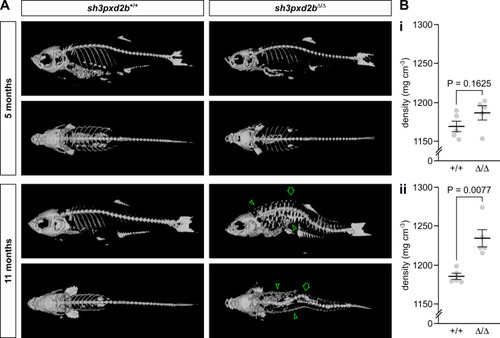
Adult sh3pxd2bΔ/Δ zebrafish develop kyphoscoliosis and an increased cutaneous density. (A) Representative µCT 3D renders of sh3pxd2bΔ/Δ mutant fish and sh3pxd2b+/+ WT clutch mates at the age of 5 and 11 months, selected form a total of five assessed fish per genotype per time point, imaged with a Siemens Inveon CT. At 5 months of age, mutant fish have a relatively small, up-tilted skull as compared to their WT clutch mates. At 11 months, mutants have developed kyphoscoliosis (outlined arrow). The skin of mutants shows an increased density (outlined arrow heads), that is not present at 5 months of age. Note that the fish displayed here had all the phenotypical features listed in Table 1 (see Fig. S2 for gross anatomy images). (B) Tissue density measurements of the five scanned fish per genotype per time point. At 5 months of age (i), there is a slight increase in overall tissue density of mutant (Δ/Δ) fish compared to their WT (+/+) clutch mates, which is however not statistically significant (NS; P=0.1625). At 11 months of age (ii), the overall tissue density of mutant fish is significantly increased compared to their WT clutch mates (P=0.0077; assessed by two-sampled, non-pooled, two-tailed Student's t-test). Error bars represent standard error of means of biological replicates.
|

